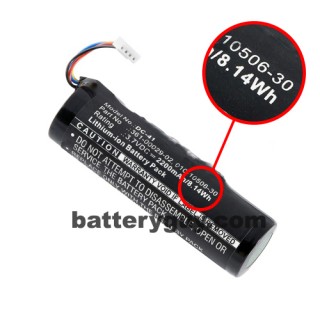Lithium is a relatively new technology and there are concerns about its stability. Most notably, this battery type has been known to spontaneously overheat and catch fire, which has understandably lead to the introduction of restrictions by airlines and transport companies. In reality, most lithium based batteries now come with built in safety systems to avoid these dangers, but the rules in place by the US Federal Aviation Administration remain. These are laid out in the regulation 49 CFR 175.10(a)(18).
Note, this article explains the restrictions on an individual person when traveling by air with lithium metal batteries (disposable) and lithium-ion batteries and battery packs (rechargeable). If you are shipping lithium batteries please see shipping lithium batteries.
Air travel restrictions revolve around:

- The amount of lithium (or lithium equivalent) content in a battery or battery pack – this can be worked out as 0.3 x amp hour capacity. So a 2Ah battery has 0.6 grams of lithium (2 x 0.3) and a typical laptop battery pack with eight 2Ah cells has 4.8 grams (8 units x (0.3 x 2Ah))
- Watt Hour (Wh) limits – This is usually stated on the battery itself. If not, you can calculate it as Volts x ampere hour (Ah).
- example 1: an 11.1 volt 4,400 mAh battery – first divide the mAh rating by 1,000 to get the Ah rating – 4,400/1,000 – 4.4ah. You can now calculate as – 4.4Ah x 11.1 volts = 48.8Wh
- example 2: a 12 volt 50 Ah battery – 50 Ah x 12 volts = 600Wh
What you need to know
Installed or spare – The rules reference “batteries installed in devices” and “spare batteries” and it is important to be aware of the difference. The regulations state that a device “containing lithium metal or lithium-ion cells or batteries the primary purpose of which is to provide power to another device must be carried as spare batteries”. In other words a battery mounted in a battery charger is regarded as a spare battery.
Condition – As it is abused lithium batteries that are most likely to overheat and catch fire, any sign of damage could mean the battery is not allowed onto the flight.
How to pack – Batteries installed in a device can be in both checked or carry-on luggage. Spare batteries can only be taken in carry-on luggage and must be packed in such a way as to ensure the terminals cannot short circuit. This is a possibility on many units because the terminals are close together and could be shorted out by a simple piece of lose metallic foil. The FAA recommends:
- using the original retail packaging where possible or;
- taping over the terminals or;
- placing each battery in a protective pouch or container.
Number of spare batteries – in theory no restrictions for batteries rated below 100 watt hours, but all spare batteries must be for “personal use”. This means a sales rep cannot take ‘samples’ on board, even in hand luggage.
Lithium Metal (disposable lithium batteries) – No more than 2 grams of lithium per battery (see above on how to calculate this).
Lithium Ion (rechargeable batteries) – Each battery cannot exceed a rating of 100 Watt-hour unless you have express permission from the airline. However even in this case, you are limited to a maximum of two batteries with maximum ratings of 160 Watt-hour and they must be in carry-on luggage only. There is an exception for Lithium-Ion wheelchair batteries up to 300 Watt-hours, but limited to one battery and it must be disconnected. See above for how to find out the Watt-hour rating of your batteries.
Where to keep them – for spare batteries it is recommended that they are removed from your hand luggage once you board the plane and kept close to you. This is so should any issues arise with the batteries you are quickly aware of it and the cabin crew have easy access to deal with the situation.
Unclear areas
Batteries in hoverboards are an area of debate. If you plan to travel by air with one, check with the operator first in case they have any specific restrictions in place.
Video on air travel with lithium batteries
The following video is guidance for crew members from the Civil Aviation Authority (CAA) but it is well worth watching so you know how lithium battery fires are dealt with by crew and how you can assist if needed.


How can you tell if a rechargeable battery installed in a device contains lithium? And how to you calculate watt hours when all you have is V, Hz and A (no Ah or mAh)?
The battery should be marked Lithium Ion or Rechargeable Lithium. If in question, call the original equipment manufacturer as to which type of battery they have used. Hz is a measure of reciprocal time. Watts is a measure of power, the rate of energy transfer. Unfortunately this is like comparing inches to degrees. As far as A, this probably stands for Ampere, which is the same as AH or amps. Your may want to verify this prior to proceeding with any calculations, but this should hold true.
The standard formula for calculating watts is:
Watts = Volts * Amps
What if I discharge the battery before flying? Are the rules based on total capacity or on available charge? Also, even though my battery pack is rated at 82500mAh (297Wh), the specs also say that the “battery cell” is 2750mAh*3.6V (or by my calculation about 9.9Wh). Thanks for any guidance!!!
It doesn’t really help because airlines have no way to measure the state of charge on most batteries so they don’t know it is completely discharged.
Can I take my Lithium 2600mAh, 3.7V, 9.62 Wh
Battery as a carry on through TSA? Cannot convert using formula. Just need a yes or no. I will remove the battery from the light, tape the positive end and carry separate in case I bought.
Paul C
You need to check the rules of the airline. Usually they are absolutely fine as long as you declare it at check-in.
Lithium ion battery extended label on my battery says 14.4V 6.5Ah, 93.6Wh x 2. does that mean it is within the range of FAA requirements. Since the consumption of the battery is as per standard better. However it extend the time I can use it. My portable oxygen concentrator is FAA approved.